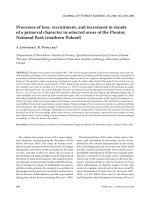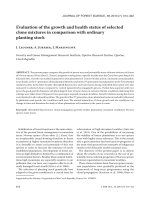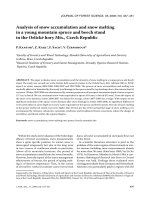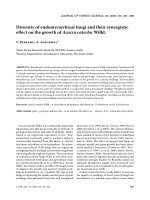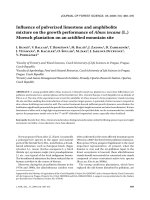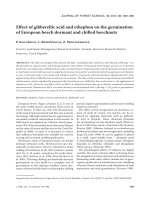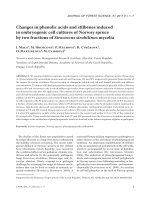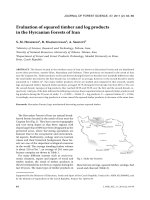Báo cáo lâm nghiệp: "Ionic interactions between precipitation and leaf cuticles" ppt
Bạn đang xem bản rút gọn của tài liệu. Xem và tải ngay bản đầy đủ của tài liệu tại đây (199.54 KB, 4 trang )
Ionic
interactions
between
precipitation
and
leaf
cuticles
T.
Scherbatskoy
University
of
Vermont,
Botany Department,
Burlington,
VT 05405,
U.S.A.
Introduction
The
leaf
cuticle
is
the
most
important
rate-
limiting
barrier
controlling
the
movement
of
solutes
between
precipitation
and
the
leaf
interior,
but
the
mechanisms
and
rates
by
which
ions
diffuse
through
the
cuticle
remain
poorly
defined.
There
is
strong
experimental
evidence
that
cuticles
contain
hydratable
pores
up
to
0.45
nm
in
radius
lined
with
polar
groups
(McFarlane
and
Berry,
1975;
Sch6nherr,
1979;
Seymour,
1980).
These
hydrophilic
regions
in
cuticles
probably
incorporate
the
polar
substituents
of
waxes
and
cutin,
as
well
as
polyuronic
acids
of
the
polysaccharides
in
the
secon-
dary
cuticle.
These
polar
groups
and
polar
pores
are
likely
to
contribute
greatly
to
the
ion
exchange
capacity
and
transport
prop-
erties of
cuticles.
This
research
examined
the
ionic
interactions
between
leaf
surfaces
and
precipitation,
particularly
the
role
of
the
leaf
cuticle
in
mediating
ion
transport
into
and
out
of
the
leaves.
Materials
and
Methods
Ionic
exchange
Individual
50
pl
drops
of
artificial
precipitation
representing
regional
ambient
precipitation
at
pH
3.8
or
5.4
were
applied
to
adaxial
and
ab-
axial
surfaces
of
mature,
field-grown
Acer
sao-
charum
leaves
which
had
been
rinsed
with
deionized
water.
Ten
experiments
were
con-
ducted
at
weekly
intervals
between
July
and
September
in
a
high-humidity
chamber
to
re-
duce
drop
evaporation.
Drops
were
quantita-
tively
removed
after
precise
times
between
4
and
128
min
and
analyzed
for
Cu
2
+,
Pb
2
+,
Zn2+,
K+,
Ca
2+
and
Mg2+.
Electrophysiology
Adaxial
cuticles
were
enzymatically
isolated
(Orgell,
1955)
from
mature
leaves
of
several
tree
species.
Diffusion
potentials
across
cuticles
were
measured
in
a
flow-cell
by
pumping
unbuffered
salt
solutions
across
the
two
sides
of
the
cuticle
to
create
ion
concentration
gra-
dients.
Electrical
potentials
across
the
cuticle
were
measured
for
various
concentration
ratios,
G,IC
o,
and
were
expressed
as
E!!=
=
(y
f i
- y
f 0
),
where y
is
the
local
voltage
and
the
super-
scripts
refer
to
inside
and
outside
the
cuticle.
Results
Concentrations
of
Cu
2+
and
Pb
2+
remain-
ing
in
applied
solutions
declined
rapidly
with
time
at
pH
5.4
(Fig.
1);
this
was
more
pronounced
on
adaxial
leaf
surfaces.
Concentrations
of
Zn
2+
were
unchanged
under
all
treatments.
K+,
Ca
2+
and
Mg
2+
to
increase
with
time,
more
so
at
pH 3.8.
Diffusion
potentials
are
graphed
in
Fig.
2
for
A.
saccharum
in
KCI
under
2
ex-
perimental
regimes:
1)
constant
10-fold
concentration
ratios
at
different
ionic
strengths,
and
2)
constant
average
ionic
strength
(10
mM)
at
different
concentration
ratios.
These
graphs
show
2
important
responses
typical
for
all
species:
diffusion
potentials
increased
with
decreasing
ionic
strength,
and
potentials
were
asymmetric,
being
smaller
when
Ci
IC,
>1.
Discussion
and
Conclusion
In
the
ion
exchange
experiments,
adsorp-
tion
of
CU2+
and
Pb2+
was
reduced
at
the
lower
pH.
This
is
consistent
with
a
reduc-
tion
in
available
exchange
sites
for
cation
adsorption
at
the
higher
H30+
concentra-
tion.
Increased
H30+
concentration,
on
the
other
hand,
would
favor
the
release
of
K+,
Ca
2+
and
Mg
2+
from
adsorption
sites
on
the
leaf
surface.
The
kinetics
in
these
experiments
can
be
used
to
predict
cuticular
permeability
coefficients
(P)
that
would
be
required
if
this
was
the
only
exchange
mechanism
operating.
This
leads
to
apparent
cuticular
P
=
10-
5
and
10-
4
cm-s-
I
for
Cu
2+
and
Pb
2
+,
respectively.
These
are
much
too
large
to
represent
cuticular
permeation,
suggesting
instead
that
surface
adsorption
mechanisms
dominate.
For
K+,
Ca
2+
and
Mg
2
+,
on
the other
hand,
the
calculated
apparent
Ps
are
similar
to
those
measured
in
isolated
cuticles
(McFarlane
and
Berry,
1974;
Reed
and
Tukey,
1982).
These
rates
suggest
a
different
mechanism
may
be
operating
for
these
cations.
It
is
pos-
sible
in
this
case
that
prerinsing
the
leaves
may
have
removed
most
of
the
ex-
changeable
K+,
Ca
2+
and
Mg
2+
from
the
surface,
so
that
cuticular
permeation
was
mostly
responsible
for
the
efflux
of
these
cations
into
solutions.
Using
published
Ps
to
predict
exchange
times,
calculations
show
that
half-times
for
cation
exchange
between
the
apoplast
and
precipitation
by
cuticular
permeation
is
about
10
days.
In
the
electrophysiology
experiments,
diffusion
potentials
approached ± 59
mV
at
low
ionic
strength
when
the
concentra-
tion
ratio
was
0.1
or
10
(Fig.
2),
confirming
the
Nernstian
behavior
of
this
system.
The
increase
in
potential
with
decreasing
ionic
strength
indicates
that
the
permeability
ratio,
P
cationlPan
i
on
increased
as
ionic
strength
decreased;
this
was
due
to
ionic
partition
coefficients
changing
with
ionic
strength.
The
asymmetry
of
the
potentials
varied
among
cuticles
and
appeared
to
be
caused
by
the
asymmetric
distribution
of
negative
charge
in
the
cuticle.
Potentials
were
inadequately
modeled
by
the
Goldman
equation,
apparently
due
to
changing
permeability
ratios
within
the
cuticle.
Pure
cellulose
membranes
(pre-
sumed
to
be
more
structurally
homo-
geneous
than
cuticles)
did
allow
a
good
fit
between
predicted
and
observed
poten-
tials
(Fig.
3).
The
importance
of
electrical
potential
was
evaluated
by
comparing
the
driving
force
for
ionic
flux
due
to:
1)
only
chemical
potential,
or
2)
electrochemical
potential.
Potentials
were
measured
while
mimicking
natural
conditions
by
applying
artificial
aci-
dic
precipitation
to
the
outside
of
the
cuticle
and
artificial
apoplastic
solution
to
the
inside.
At
pH
3.8,
there
was
little
dif-
ference
in
the
driving
force
between
the
two
models.
At
pH
5.4,
however,
ignoring
the
electrical
potential
resulted
in
over-
estimating
the
driving
force
for
cations
by
a
factor
of
2.
This
work
showed
that
cuticular
permea-
tion
and
ion
exchange
between
precipita-
tion
and
the
leaf
apoplast
do
not
occur
at
biologically
significant
rates.
Instead,
ion
exchange
processes
with
the
leaf
cuticle
surface
dominate.
Electrophysiology
stu-
dies
showed
that
significant
diffusion
potentials
can
arise
across
cuticles
and
these
can
have
a
significant
effect
on
ionic
flux.
Furthermore,
ionic
permeability
in
cuticles
varied
with
both
ionic
strength
and
cuticle
structure.
References
McFarlane
J.C.
&
Berry
W.L.
(1974)
Cation
pene-
tration
through
isolated
leaf
cuticles.
Plant
Phy
siol.
53,
723-727
Orgell
W.H.
(1955)
The
isolation
of
plant
cuticle
with
pectic
enzymes.
Plant
PhysioL
30,
78-80
Reed
D.W.
&
Tu4;ey
H.B.
(1982)
Permeability
of
Brussels
sprouts
and
carnation
cuticles
from
leaves
developed
in
different
temperatures
and
light
intensities.
In:
The
Plant
Cuticle.
(Cutler
D.F.,
Alvin
K.L.
&
Price
C.E.,
eds.),
Linnean
Society
of
London
International
Symposium,
London,
8-11
Sept.
1980.
Academic
Press,
London, pp. 267-278
Sch6nherr
J.
(1979)
Transcuticular
movement
of
xenobiotics.
In: Advances
in
Pesticide
Science
(Geissbuhler
H.,
Brooks
G.T
&
Kearne
P.C.,
eds.),
Papers
from
the
Fourth
International
Congress
of
Pesticide
Chemistry,
Zurich,
24-28
July
1978.
Pergamon,
Oxford,
pp.
392-400
Seymour
V.A.
(1980)
Leaf
cuticle:
an
investiga-
tion
of
some
physical
and
chemical
properties
derived
from
a
study
of
Berberis.
Ph.D.
Thesis,
University
of
Washington,
Seattle
